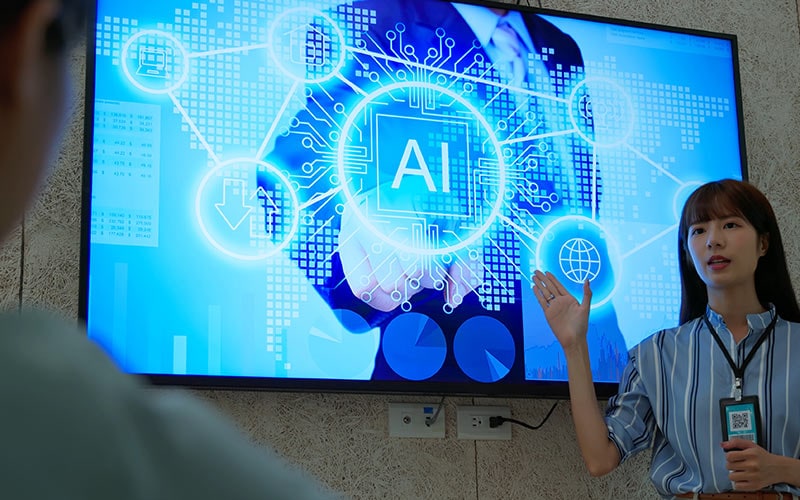Insights
- For the past few years, traditional retailers have been experiencing turbulence and the pandemic only made it worse. At the same time, digital natives grew rapidly.
- To stay competitive, traditional retailers are turning to Agile methodologies. However, a few are reaping more benefits than others.
- Our research for ‘Agile Radar 2021’ revealed business-IT misalignment, and legacy systems and thinking as the primary roadblocks to retailers’ Agile transformation.
- To win in the global digital marketplace, the right mix of Agile strategies and levers can help traditional retailers stay competitive against digital natives. Using these, retailers can create a customer-centric culture that uses data and product-based approach to deliver customized offerings.
The pandemic aggravated challenges for the already struggling brick-and-mortar retail sector. In the U.S. alone, more than three dozen major retailers filed for bankruptcy in 2020.1 At the same time, digital native retailers grew significantly. To survive, traditional retailers are strengthening their online presence and merging their physical and digital worlds. For example, Walmart announced that it planned $14 billion worth of capital expenditures in the 2022 fiscal year to strengthen its e-commerce fulfillment capabilities.2
Agile techniques are being used to fuel this metamorphosis. The hope is that Agile’s speed and flat-decision making will result in the quicker development of new customer-centric digital functions.
But some are deploying Agile better than others.
The need for digital dexterity, upskilling, and data agility
Agile is most successful when cross-functional teams come together to solve problems. Business and IT must be in the same room, with the endorsement of senior leadership. Jeff Bezos was able to make Amazon successful in part because no single unit was allowed to develop software in silos.3 This is a problem for many retailers. They generally have a culture of division; business and IT leaders sit in their high castles, unwilling to share knowledge or collaborate.
We surveyed 1,000 respondents for the Infosys Agile Radar 2021 report, where 19% of the sample represented the consumer packaged goods (CPG), retail, and logistics sector. The research highlighted business-IT misalignment and legacy thinking and systems as the two biggest challenges to retailers’ Agile transformation.4 These collectively slow decision-making and result in lost opportunities.
The same research also revealed that retailers that used customer insights were able to achieve superior business outcomes. Investment in product management, emphasis on customer journeys, and DevSecOps give management a new way to conduct business. Firms are increasingly using design and systems thinking to build the right products. And they use Agile levers, such as cross-functional collaboration, that work at scale.
For example, retail firms such as Ocado in the U.K. are using the right Agile strategies and behaviors to rethink how their brands will evolve.5 Ocado’s operating model is software-defined. The company pours money into experimentation and learning, and builds products based on deep customer insights, rigorous market testing, and the creation of minimum viable products (MVPs). The company’s research and development is so significant that it has spun off two separate business lines — Ocado Technology and Ocado Engineering.
Traditional retailers that lag in these areas can do three things to close the gap with digital natives. These strategies make sure they successfully bring together brick-and-mortar and e-commerce into both the business and operating models:
- Increase digital dexterity — This requires a solid technology backbone, including cloud-native e-commerce and point-of-sale systems. Visionary firms (“Sprinters” in our Agile Radar research) use these advances to enhance user experience with in-store automation and optimal merchandising processes.
- Enhance workforce agility — This means valuing the team over individual brilliance. Upskilling is conducted through boot camps, hackathons, and collaboration tools. The best retailers are able to source expertise from both local and global talent pools.
- Make data do the work — Data agility enables the faster launch of digital experiences while optimizing supply chain and inventory. With this approach, data cuts across business functions and value streams, with insights shared between business and IT.
The five levers of retail business success
Top-performing firms are user-centric and data driven. These are typically organized around value streams and backed by strong yet lean governance models and engineering practices (see Figure 1). When these five levers are used as part of a holistic Agile strategy, retailers are able to redefine the way they do business and deliver better customer experiences. Infosys research also found that these firms report greater growth than their peers.
Figure 1. How to become a retail 'Sprinter'
Source: Infosys
Embrace user centricity
User centricity keeps customers as the focus of design and engineering, with strong synergy between business and technology teams. This helps establish a better understanding of user journeys, usage patterns, and challenges faced by both returning and new customers. In turn, this collaboration helps shape product features that are most desirable by customers and will have impact in the market. In our research, we found that remapping customer journeys and collecting insights through data analytics were the two most important business success levers.6
The use of design and systems thinking helps firms build products that customers want and identifies the right channels to serve customers. In this process, business and domain experts come together to identify key customer personas and better understand their usage patterns. This then simplifies and personalizes the shopping experience. Additionally, retailers can create MVPs with frequent releases and receive early feedback through close user involvement. Quick adjustments can then be made, ensuring the product strategy is more likely to succeed.
Businesses reported growth in market share, revenue, and employee satisfaction by remapping customer journeys and collecting insights
Infosys worked with a global beauty, household, and personal care product marketing company to help it focus on user centricity as it developed its business-to-business selling platform. This platform enhances the sales representative experience and provides customer insights. Ultimately, this led to a nearly 45% increase in the company’s customer acquisition rate.
Create value stream-based organizational structures
Product-centric teams organized around business value streams ensure that service delivery is resilient. Here, the focus is on creating an integrated view of the product value chain, which we’ve found leads to better business outcomes. By combining development and operations, these teams are more agile and have the capabilities needed to build products faster. This product-centric approach also breaks silos using cross-functional and autonomous teams. Transparency between different business lines increases, and there is a much closer alignment between business and IT.
In such organizational structures, enterprise-wide capabilities are shared. Platform engineering teams support product teams on vital features in the product backlog. They often focus on capability reuse, automation, and self-service. This increases agility and accelerates time-to-market.
In one Infosys engagement with a European retail and wholesale giant, the company created integrated DevOps teams structured around value streams. The business created a cost-efficient product development model that improved customer experience and increased its online presence. The transformation further helped the company increase savings through better inventory management, delivery efficiency, and improved collaboration between business and technology.
Establish a data-driven and experimental product mindset
A culture of rapid experimentation and focus on outcomes rather than outputs are the keys to product-based value delivery. In this operating model, product teams prioritize features that create improved business capabilities. The emphasis stays on innovation, collaboration, and autonomy to empower teams. MVPs are created incrementally through a build-measure-learn cycle of engagement. The measure and learn part of product development is data-driven, with insights into whether customers really want the product being built. If results are poor, the team may choose to go ahead with new features or abandon the features altogether and build something new. Results are gathered incrementally and continuously, with a road map that has buy-in from senior sponsors in the organization.
Cultural shift towards rapid experimentation and focus on outcomes hold the key to successful adoption of product-based value delivery
Additionally, hackathons help teams ideate possible features for their products. This leverages a team’s combined experience and knowledge, and allows ideas to cut across different value chains in the retail product life cycle. Hackathons also enhance collaboration between engineering, product, and business teams, which compounds benefits.
In one venture with a U.S.-based food distributor, hackathons were run across more than 20 geographical teams with pools of experts from different knowledge domains. This resulted in a number of disruptive business solutions that brought together AI (image recognition), machine learning, knowledge graphs, and geofencing.
Engineering agility
Engineering agility requires strong capabilities in automation, DevSecOps, microservices, and feature-driven development. It also has metrics built into the solution by ensuring quality engineering has a seat at the table and that a good test data strategy is in place.
According to our Agile Radar research, DevSecOps is a top IT investment for retailers. When it is brought early into the software development life cycle, technical debt goes down and companies achieve faster outcomes. Cloud also leads to increased capabilities and business outcomes such as higher release frequencies and efficient operations.
A large global sportswear brand migrated its monolithic on-premises order management system to the cloud and adopted a microservice-based model using DevSecOps practices. This saved more than half a million dollars through a reduction in call center costs, better applications at scale, and zero downtime.
Establish a lean governance model
Product-centric Agile teams deliver the best outcomes when there are metrics that continuously track progress and course corrections. This requires a transparent governance model with robust objectives (both short and long term) and measurement of objectives and key results (OKRs). These OKRs for retailers include reduced cycle time for browse-to-buy, increased add-to-cart rates, expansion of market share for specific customer segments, and better shopper sentiment. Funding for new products will be linked to these OKRs, both in brick-and-mortar and e-commerce operations.
OKRs have been an important tenet in Amazon’s success.7 The company aligns customer desires, such as low product prices and rapid delivery, with workforce objectives. This includes a culture of learning, MVP-based innovation, and the development of a lean startup operating model. When taken together, these OKRs enable new innovations such as the Kindle, drone delivery, and automated checkout shopping at Amazon Go stores.
Transparent governance can be established through digital dashboards, which are accessible to teams across functions and enable a one-team culture. These dashboards cover a wide array of metrics, including performance, Agile maturity, and the ability to deliver against business outcomes.
Driving retail agility across business and IT ecosystems
Retailers need both product-centric agility and business resilience to fight economic anxiety. This means going on the offensive with research and development while crafting product-centric strategies and expanding into new markets. For this, a platform-centric cloud infrastructure is needed. Funding for new products will be linked to specific outcomes and key objectives. Keeping resources agile is the key to success. Firms such as Whole Foods Market rapidly moves people, technology, and capital among initiatives — out of stagnant product lines and into fast-growing areas.
The five levers of retail agility will enable forward-thinking retailers to make these quick decisions and create more effective operating models. The very best Agile firms take tiny steps on the way to growth and greater business performance, transforming from “doing” Agile to “being” Agile as a core part of the firm’s DNA.
By crafting the right Agile strategy and adopting optimal technology, the most resilient retailer will define an era where buyers and sellers transact, share, and generate value on a common digital platform. The boundaries will blur between the physical and digital worlds as direct-to-consumer models become more prominent. And oftentimes, firms will feel they are stronger working together as they define new business models for the good of retail customers in a global digital marketplace.
References
- The 10 biggest retail bankruptcies of 2020, Lauren Thomas, Dec. 26, 2020, CNBC.
- Walmart says its automated supply chain is ‘ready to scale’, Matt Leonard, Feb. 19, 2021, Supply Chain Dive.
- The Bezos API mandate: Amazon’s manifesto for externalization, Jan. 19, 2021, NORDIC APIs.
- Infosys Agile Radar 2021, July 2021, Infosys Knowledge Institute
- Ocado Technology adopts lean and Agile development practices, James Donkin, Emily Page, Lawrence Weetman, et al., March 8, 2017, BrightTALK.
- Infosys Agile Radar 2021, Infosys Knowledge Institute.
- To create better company OKRs, follow Jeff Bezos’ advice, Felipe Castro, Jan. 8, 2018, Felipe Castro blog.






